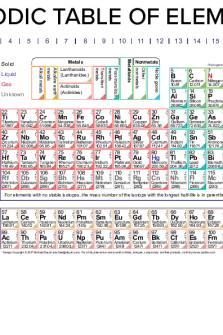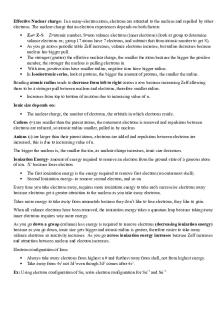AP Chem unit 7&8 - effective nuclear charge, trends of periodic table with respect to atomic mass, PDF

| Title | AP Chem unit 7&8 - effective nuclear charge, trends of periodic table with respect to atomic mass, |
|---|---|
| Course | AP Chemistry |
| Institution | High School - USA |
| Pages | 4 |
| File Size | 105.8 KB |
| File Type | |
| Total Downloads | 62 |
| Total Views | 139 |
Summary
effective nuclear charge, trends of periodic table with respect to atomic mass, atomic radius, ionic strength...
Description
Effective Nuclear charge: In a many-electron atom, electrons are attracted to the nucleus and repelled by other electrons. The nuclear charge that an electron experiences depends on both factors
Zeff= Z-S Z=atomic number, S=non valance electrons (inner electrons) (look at group to determine valance electrons ex; group 17 atoms have 7 electrons, and subtract that from atomic number to get S). As you go across periodic table Zeff increases, valance electrons increase, but radius decreases because nucleus has bigger pull. The stronger (greater) the effective nuclear charge, the smaller the atom because the bigger the positive number, the stronger the nucleus is pulling electrons in With ions, positive ions have smaller radius, negative ions have bigger radius. In Isoelectronic series, look at protons, the bigger the amount of protons, the smaller the radius.
Bonding atomic radius tends to decrease from left to right across a row because increasing Zeff allowing there to be a stronger pull between nucleus and electrons, therefore smaller radius.
Increases from top to bottom of an atom due to increasing value of n.
Ionic size depends on:
The nuclear charge, the number of electrons, the orbitals in which electrons reside.
Cations (+) are smaller than the parent atoms, the outermost electrons is removed and repulsions between electrons are reduced, so atomic radius smaller, pulled in by nucleus Anions (-) are larger than their parent atoms, electrons are added and repulsions between electrons are increased, this is due to increasing value of n. The bigger the nucleus is, the smaller the ion, as nuclear charge increases, ionic size decreases. Ionization Energy- amount of energy required to remove an electron from the ground state of a gaseous atom of ion. X+ because loses electron
The first ionization energy is the energy required to remove first electron (on outermost shell). Second Ionization energy- to remove second electron, and so on
Every time you take electrons away, requires more ionization energy to take each successive electrons away because electrons get a greater attraction to the nucleus as you take away electrons. Takes more energy to take away from nonmetals because they don’t like to lose electrons, they like to gain. When all valance electrons have been removed, the ionization energy takes a quantum leap because taking away inner electrons requires way more energy. As you go down a group (column) less energy is required to remove electrons (decreasing ionization energy) because as you go down, ionic size gets bigger and atomic radius is greater, therefore easier to take away valance electrons so reactivity increases. As you go across ionization energy increases because Zeff increases and attraction between nucleus and electron increases. Electron configuration of Ions:
Always take away electrons from highest n # and furthest away from shell, not from highest energy. Take away from 4s2 not 3d2 even though 3d2 comes after 4s2.
Ex: Using electron configuration of Sn, write electron configuration for Sn+2 and Sn+4
Electron Affinity: the energy change accompanying the addition of an electron to a gaseous atom. Cl+e-=Cl-. ***Non-metals have higher electron affinity Electron affinity becomes more exothermic as you go from left to right across a period because energy will be released and the more energy released, the more the atom will want electrons Noble gases mostly zero, don’t want to gain or lose electrons. In Groups 1 & 2- added electron must go into p orbital, not an S orbital, the electron is further away from the nucleus and feels repulsion from S orbital. In Groups 14 & 15: group 14 has no empty orbitals. The extra electron must go in an already occupied orbital, creating repulsion. •
The greater the attraction between an atom and an added electron , the more negative the atom’s electron affinity.
•
Ionization energies are positive, as energy must be absorbed to take away an electron.
•
However, electron affinity is a negative value
C6:
N7:
**Metals become more metallic as you go from right to left () and down a group.
Most metal oxides are ionic salts that are basic. Ex: Na2O, MgO. When dissolved in water form hydroxides. Metals tend to form cations (+) in aqueous solutions.
Ex: would you expect Scandium oxide to be a sold liquid or gas at room temp?
Solid because scandium oxide makes an ionic salt which are solids
Write a balanced chemical equation for the reaction of scandium oxide with nitric acid. *treat as neutralization reaction (h2o as product) Non-metal oxides are acidic, when dissolved in water they form acids: CO2 + H2O H2CO3. Ex:
Group 1: alkali metals
Have low ionization energies. Except Li, react with oxygen to form peroxides.
Group 2: Be does not react with water and Mg only reacts with water vapor. Rest will react
Low ionization energies but group 1 lower. Reactivity increases as you go down group since ionization decreases as you go down group so easier to share electrons
Group 17: have large negative electron affinities therefore they tend to oxidize other elements easily. They react with metals to form metal halides. Group 18: the noble gases have astronomical Ionization energies
Their electron affinities are positive, therefore they are relatively unreactive. They are found as monoatomic gases. Xe forms 3 compounds: XeF2, XeF4, XeF6 Kr forms only one stable compound: KrF2
Octet Rule: elements tend to gain, lose, or share elements until they are surrounded by 8 valance electrons. Lewis Dot Diagram: Shows valance electrons as dots around the symbol of elements. With ions put brackets and charge around Lewis dot diagram. Lattice Energy: the energy required to completely separate a mole of a solid ionic compound into its gaseous ions. Breaking apart ionic structure is endothermic, putting it together is exothermic. Energy + NaCl Na++ Cl
The greater the charge of the ion the greater the lattice energy (look at that first). As distance of atom goes up, lattice decreases As distance between atoms gets closer, lattice energy increase ** when determining distance look how far down the group atoms are, the further down the greater distance and lower lattice energy.
EX:
Polar covalent bonds: electrons not shared equally one atom has stronger pull. Usually compound with F more polar. The closer the element is the fluorine the more polar it is. Electronegativity increase as you go from left to right and from bottom to top. Writing Lewis structures: 1. Find sum of valance electrons, multiply by coeff if needed, if cation, subtract electron, if anion, add. 2. The central atom is the least electronegative that isn’t hydrogen. Connect the outer atoms to it by single bonds, each bond=2 electrons. 3. Fill octet of outer atom 4. Fill octet of central atom 5. If you run out of electrons before central atoms has an octet, use form multiple bonds until it is stable. Sulfur, Carbon, Nitrogen, usually make double bonds. Triple bonds can occur between carbon and nitrogen.
Carbon most likely has double bonds, CO2, CO3-2
EX: CO2
SO3
Assign formal charges: for each atom in structure:
Valence electrons - (
1 (electrons shared covalent bonds) + electrons in lone pairs) 2
The best Lewis structure has:
The fewest charges puts a negative charge on the most electronegative atom
Resonance: single, double, triple bonds are able to interchange as long as interchanging between same elements like (O) within the structure. Ozone (O3) Bond strength weak intermediate strong
Single Double Triple
Bong length long intermediate short
Ex: Order from shortest to longest: CO, CO2 CO3-2
Bond enthalpy- the strength of a bond is measured by determining how much energy is required to break the bond. (Breaking bonds- endothermic, forming bonds exothermic!!) Enthalpies of Rxn: (
∑H
bonds broken -
∑H
bonds formed)
Ask what is being broken in reactants and what is being formed in products. If reaction as coeff, count how many bonds broke/formed and multiply by coeff. Table will be given to convert. EX:...
Similar Free PDFs

Periodic Trends
- 4 Pages

Copy of Periodic Trends Analysis
- 3 Pages

History of Periodic Table
- 1 Pages

Periodic table
- 2 Pages

Graphing Periodic Trends
- 3 Pages

Periodic-table
- 1 Pages

Periodic Trends - Notes
- 2 Pages

04 periodic trends lab
- 6 Pages

Periodic Trends Investigation
- 8 Pages

Periodic trends assignment(2020)
- 4 Pages

Periodic Table of the Elements
- 1 Pages

Periodic Trends Pogil
- 7 Pages

Lab 0. Periodic Trends
- 6 Pages
Popular Institutions
- Tinajero National High School - Annex
- Politeknik Caltex Riau
- Yokohama City University
- SGT University
- University of Al-Qadisiyah
- Divine Word College of Vigan
- Techniek College Rotterdam
- Universidade de Santiago
- Universiti Teknologi MARA Cawangan Johor Kampus Pasir Gudang
- Poltekkes Kemenkes Yogyakarta
- Baguio City National High School
- Colegio san marcos
- preparatoria uno
- Centro de Bachillerato Tecnológico Industrial y de Servicios No. 107
- Dalian Maritime University
- Quang Trung Secondary School
- Colegio Tecnológico en Informática
- Corporación Regional de Educación Superior
- Grupo CEDVA
- Dar Al Uloom University
- Centro de Estudios Preuniversitarios de la Universidad Nacional de Ingeniería
- 上智大学
- Aakash International School, Nuna Majara
- San Felipe Neri Catholic School
- Kang Chiao International School - New Taipei City
- Misamis Occidental National High School
- Institución Educativa Escuela Normal Juan Ladrilleros
- Kolehiyo ng Pantukan
- Batanes State College
- Instituto Continental
- Sekolah Menengah Kejuruan Kesehatan Kaltara (Tarakan)
- Colegio de La Inmaculada Concepcion - Cebu


